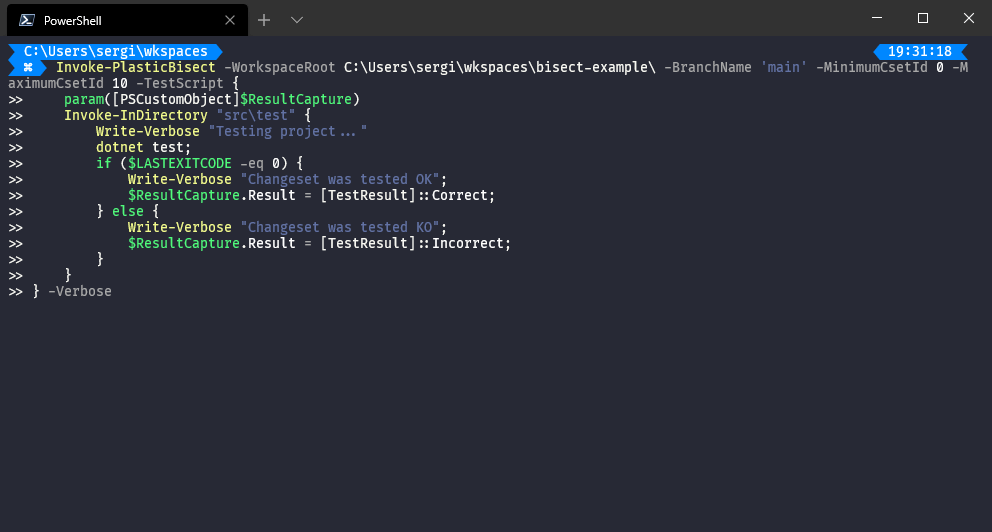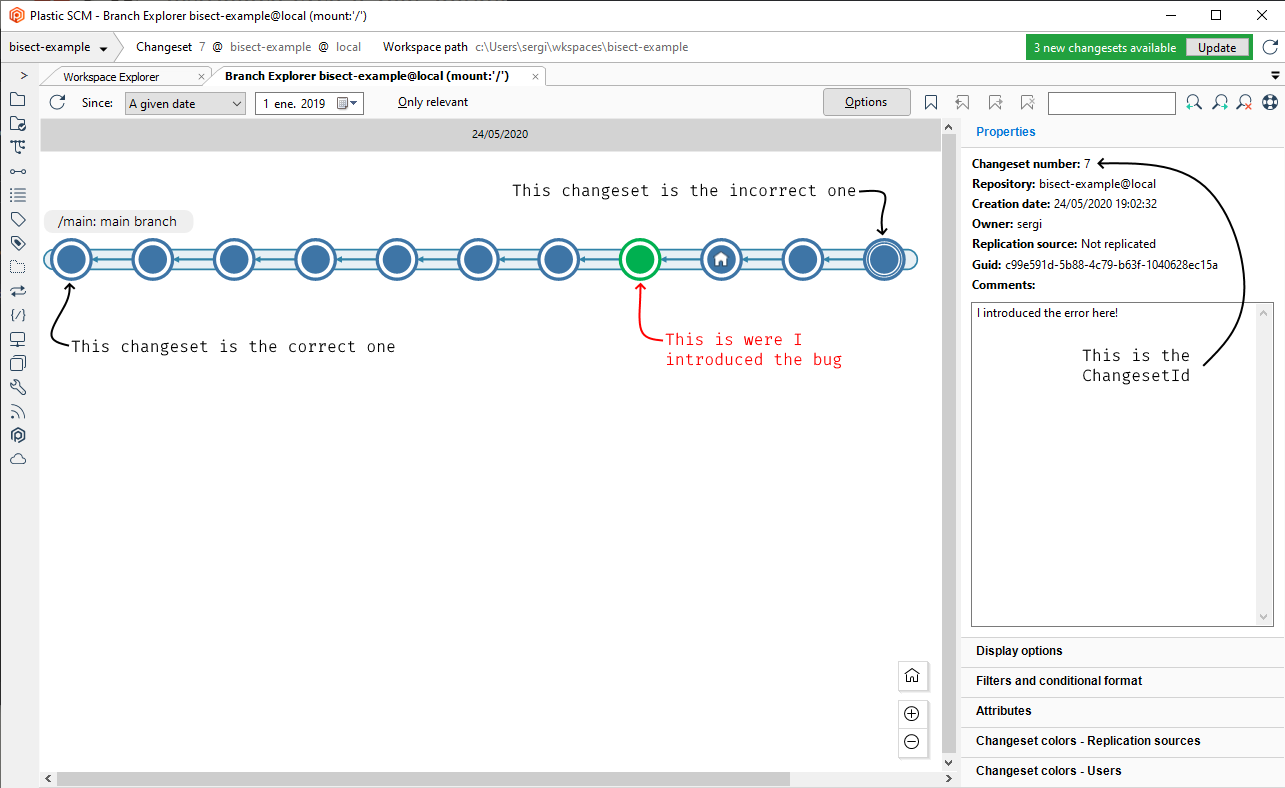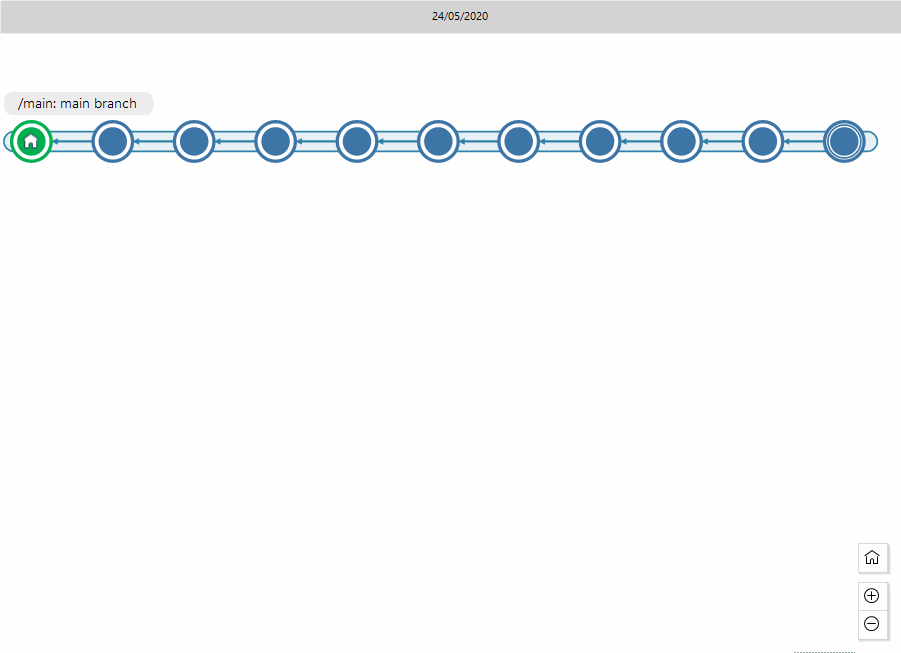A PowerShell function to bisect your Plastic SCM repository
This module has not been published yet. To get it working, do the following (customize commands as necessary!):
- Check the directory where your PowerShell install looks for its profile:
PS> $PROFILE
C:\Users\sergi\OneDrive\Documents\PowerShell\Microsoft.PowerShell_profile.ps1- Clone this repository somewhere:
PS> git clone https://github.com/PlasticSCM/PSPlasticBisect C:\PSPlasticBisect- Copy the PSPlasticBisect directory from the cloned repository to where your PowerShell install looks for modules:
PS> Copy-Item `
-Path C:\PSPlasticBisect\PSPlasticBisect `
-Destination C:\Users\sergi\OneDrive\Documents\PowerShell\Modules\- Import the module:
PS> Import-Module -Name PSPlasticBisect -Force- That's all!
When talking VCS, a bisect is finding the changeset where a bug was introduced, using binary search.
You can do so by hand, but as developers, we tend to ask computers to do the heavy lifting.
To use Invoke-PlasticBisect (and in general to bisect any repository) you only need to know two things: a changeset where there is no bug, and a changeset where there is.
We will work with two silly but important assumptions:
-
Time only goes forward.
-
We want to know the changeset where a bug was introduced, and not where it was fixed.
Under these two assumptions, the oldest changeset will be the one where everything worked OK (the correct changeset), whilst the newest one will be the one where something fails (the incorrect changeset).
Take a look at this repository I prepared. In the example, the correct changeset id will be 0, and the incorrect changeset id will be 10.
Because the bisect operation implements a binary search, these are the changesets that will get tested:
We will test each changeset using a ScriptBlock. Said ScriptBlock must receive a parameter of type PSCustomObject, and we will set the result of testing the changeset in its Result member. This Result must be a member of TestResult enum ([TestResult]::Correct, [TestResult]::Incorrect or [TestResult]::Fatal).
We do NOT need to worry to set the workspace - the bisect implementation takes care of that.
So take this as an example: in each one of the tests, I will run dotnet test and set the result depending on its exit code:
{
param([PSCustomObject]$ResultCapture)
cd ".\src\test"
dotnet test
if ($LASTEXITCODE -eq 0) {
$ResultCapture.Result = [TestResult]::Correct;
} else {
$ResultCapture.Result = [TestResult]::Incorrect;
}
}You have a helper higher-ish order function named Invoke-InDirectory. Also, if you are using the latest PowerShell 7 you can use the ternary operator, so we can nicely wrap it like this:
{
param([PSCustomObject]$ResultCapture)
Invoke-InDirectory ".\src\test" {
dotnet test
$ResultCapture.Result = ($LASTEXITCODE -eq 0) ? [TestResult]::Correct : [TestResult]::Incorrect;
}
}Putting all of the pieces together:
PS> Invoke-PlasticBisect `
-WorkspaceRoot "C:\Users\sergi\wkspaces\bisect-example" `
-BranchName 'main' `
-MininumCsetId 0 `
-MaximumCsetId 10 `
-TestScript {
param([PSCustomObject]$ResultCapture)
Invoke-InDirectory ".\src\test" {
dotnet test
$ResultCapture.Result = ($LASTEXITCODE -eq 0) `
? [TestResult]::Correct `
: [TestResult]::Incorrect;
}
}If you specify the -Verbose flag, you will see information about what's happening behind the scenes!
-
The function does not ensure a clean workspace (this is, without private files). If you want a clean workspace before each test run, it is your responsibility to clean it up at the beginning of the
TestScript. -
This module does not have any test! Pull requests implementing tests are more than welcome.
-
The bisect works in a single branch - it does not follow mergelinks. It would be really nice if it did, though!
-
You start testing branch
main. -
The bisect detects that the changeset where the bug appeared has an incoming mergelink from
main/scm25600. -
The bisect follows the mergelink to the source branch
main/scm25600and starts testing it.- It would be even nicer if the bisect was able to follow parent branches too, in case the bug was not introduced in a branch, but in its parent.
-


